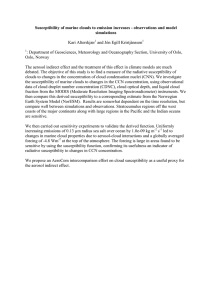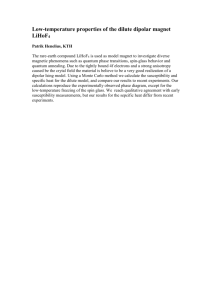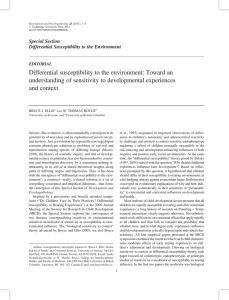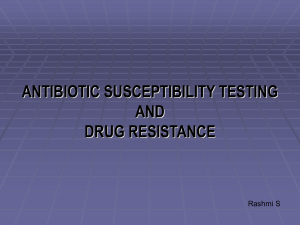ac susceptibility of structured YBa Cu O
advertisement
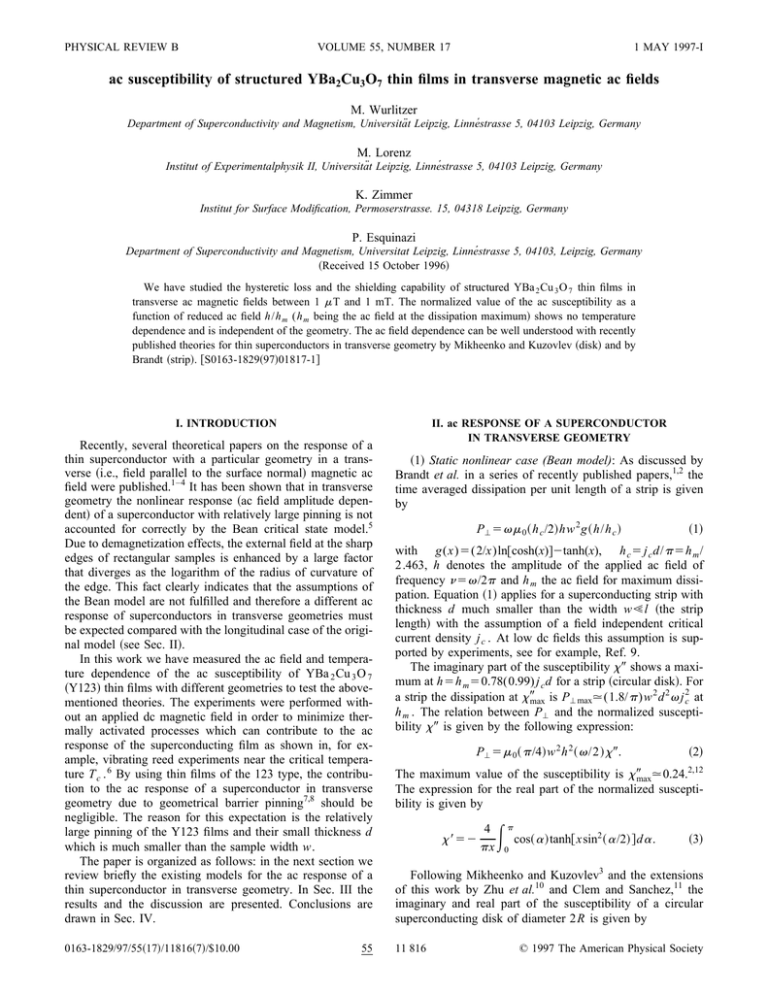
PHYSICAL REVIEW B VOLUME 55, NUMBER 17 1 MAY 1997-I ac susceptibility of structured YBa2Cu3O7 thin films in transverse magnetic ac fields M. Wurlitzer Department of Superconductivity and Magnetism, Universität Leipzig, Linnéstrasse 5, 04103 Leipzig, Germany M. Lorenz Institut of Experimentalphysik II, Universität Leipzig, Linnéstrasse 5, 04103 Leipzig, Germany K. Zimmer Institut for Surface Modification, Permoserstrasse. 15, 04318 Leipzig, Germany P. Esquinazi Department of Superconductivity and Magnetism, Universitat Leipzig, Linnéstrasse 5, 04103, Leipzig, Germany ~Received 15 October 1996! We have studied the hysteretic loss and the shielding capability of structured YBa 2 Cu 3 O 7 thin films in transverse ac magnetic fields between 1 m T and 1 mT. The normalized value of the ac susceptibility as a function of reduced ac field h/h m (h m being the ac field at the dissipation maximum! shows no temperature dependence and is independent of the geometry. The ac field dependence can be well understood with recently published theories for thin superconductors in transverse geometry by Mikheenko and Kuzovlev ~disk! and by Brandt ~strip!. @S0163-1829~97!01817-1# II. ac RESPONSE OF A SUPERCONDUCTOR IN TRANSVERSE GEOMETRY I. INTRODUCTION Recently, several theoretical papers on the response of a thin superconductor with a particular geometry in a transverse ~i.e., field parallel to the surface normal! magnetic ac field were published.1–4 It has been shown that in transverse geometry the nonlinear response ~ac field amplitude dependent! of a superconductor with relatively large pinning is not accounted for correctly by the Bean critical state model.5 Due to demagnetization effects, the external field at the sharp edges of rectangular samples is enhanced by a large factor that diverges as the logarithm of the radius of curvature of the edge. This fact clearly indicates that the assumptions of the Bean model are not fulfilled and therefore a different ac response of superconductors in transverse geometries must be expected compared with the longitudinal case of the original model ~see Sec. II!. In this work we have measured the ac field and temperature dependence of the ac susceptibility of YBa 2 Cu 3 O 7 ~Y123! thin films with different geometries to test the abovementioned theories. The experiments were performed without an applied dc magnetic field in order to minimize thermally activated processes which can contribute to the ac response of the superconducting film as shown in, for example, vibrating reed experiments near the critical temperature T c . 6 By using thin films of the 123 type, the contribution to the ac response of a superconductor in transverse geometry due to geometrical barrier pinning7,8 should be negligible. The reason for this expectation is the relatively large pinning of the Y123 films and their small thickness d which is much smaller than the sample width w. The paper is organized as follows: in the next section we review briefly the existing models for the ac response of a thin superconductor in transverse geometry. In Sec. III the results and the discussion are presented. Conclusions are drawn in Sec. IV. 0163-1829/97/55~17!/11816~7!/$10.00 55 ~1! Static nonlinear case (Bean model): As discussed by Brandt et al. in a series of recently published papers,1,2 the time averaged dissipation per unit length of a strip is given by P' 5 v m 0 ~ h c /2! hw 2 g ~ h/h c ! ~1! with g(x)5(2/x)ln@cosh(x)#2tanh(x), h c 5 j c d/ p 5h m / 2.463, h denotes the amplitude of the applied ac field of frequency n 5 v /2p and h m the ac field for maximum dissipation. Equation ~1! applies for a superconducting strip with thickness d much smaller than the width w!l ~the strip length! with the assumption of a field independent critical current density j c . At low dc fields this assumption is supported by experiments, see for example, Ref. 9. The imaginary part of the susceptibility x 9 shows a maximum at h5h m 50.78(0.99) j c d for a strip ~circular disk!. For a strip the dissipation at x 9max is P'max.(1.8/ p )w 2 d 2 v j 2c at h m . The relation between P' and the normalized susceptibility x 9 is given by the following expression: P' 5 m 0 ~ p /4! w 2 h 2 ~ v /2 ! x 9 . ~2! 9 .0.24.2,12 The maximum value of the susceptibility is x max The expression for the real part of the normalized susceptibility is given by x 8 52 4 px E p 0 cos~ a ! tanh@ xsin2 ~ a /2!# d a . ~3! Following Mikheenko and Kuzovlev3 and the extensions of this work by Zhu et al.10 and Clem and Sanchez,11 the imaginary and real part of the susceptibility of a circular superconducting disk of diameter 2R is given by 11 816 © 1997 The American Physical Society 55 ac SUSCEPTIBILITY OF STRUCTURED YBa 2 Cu 3 O 7 . . . 11 817 FIG. 1. Investigated sample geometries. x 95 S E 4 S~ x !2 p x 8 52 4 p SE S~ x !5 p 0 p 0 D sin~ a ! sin2 ~ a /2! S @ xsin2 ~ a /2!# d a , ~4! D cos~ a ! sin2 ~ a /2! S @ xsin2 ~ a /2!# d a , ~5! S D 1 sinhx arccos~ 1/coshx ! 1 , 2x cosh2 x ~6! with x5h/h c , h c 5 j c d/25h m /1.975. At low frequency where quasistatic conditions can be assumed, the static nonlinear susceptibility as a function of h/h c or h/h m is independent of the frequency and also of the FIG. 2. Temperature dependence of the ac susceptibility ~arbitrary units! for sample D1 (T c .88.5 K! for three ac fields. temperature. Higher harmonic susceptibilities within the critical state model in parallel geometry were published by Shatz et al.15 They showed that the harmonic susceptibilities are determined by a parameter which is proportional to the FIG. 3. Reduced ac susceptibility as a function of normalized ac field at different constant temperatures for sample ~a! S1 and ~b! S2 (T c .88.5 K!. The continuous lines are calculated from Eqs. ~1!–~3! without free parameters. 11 818 M. WURLITZER, M. LORENZ, K. ZIMMER, AND P. ESQUINAZI 55 FIG. 4. Reduced ac susceptibility as a function of reduced ac field at different constant temperatures for sample ~a! D2 and ~b! D3. The continuous lines are calculated from Eqs. ~4!–~6! without free parameters. ratio between applied ac field and critical current density. ~2! Linear and nonlinear ac response in the thermally activated flux flow regime: Several experiments have demonstrated the influence of thermally activated processes on the electromagnetic response of high-temperature superconductors at large enough applied dc fields.13,14,6 In the linear diffusion case the diffusivity D5 r ( v ,B,T)/ m 0 ( r is the electrical resistivity! does not depend on the amplitude of the ac field ~or current!. Following Brandt2 the approximated analytic expressions of the susceptibility for a strip are x 8 5 @ 12c1 ~ c 2 1 p 2 v 2 t 2 ! 1/2# 21 , c5 p 2 /4 ~7! x5 v t . ~8! and x 95 S 3 p 2x 1 4x ln~ x 2 11 ! 15.57 D 21 , The diffusion time t is inversely proportional to the diffusivity t 5 m 0 wd/4p D. The ac field independent dissipation @Eq. ~8!# is temperature dependent through an effective pinning barrier U eff that enters in the diffusivity, i.e., D }exp@2Ueff(T,B)/k B T # if the creep is thermally activated. At v t !1 the dissipation is simply proportional to the frequency of the ac field and to the diffusion time. In contrast to the nonlinear Bean model the maximum value of the suscep- tibility for a strip in transverse geometry is x 9max50.435. In the nonlinear diffusion model the diffusivity depends on current, or applied, ac field. Nonlinearities generate higher harmonics with an amplitude depending on the applied ac field and temperature.16,17 ~3! Nonlinear ac response in transverse geometry due to the geometrical pinning barrier: An additional mechanism for the transverse geometry is a geometrical surface barrier for the penetration of magnetic flux due to an enhanced shielding current at the edges.7,8 This effect produces a local negative magnetic permeability which was recently observed in bulk pinning free Bi 2212 single crystals18 near the critical temperature T c . For thin films with thickness d,1023 w a negligible geometrical barrier is expected due to the very small increase of the vortex energy at the edges. Our calculations based on this pinning mechanism indicate that for the used sample geometry the maximum susceptibility is x 9max;0.36 for samples with w/d>50.19 III. EXPERIMENTAL AND SAMPLE DETAILS 200 nm thick YBa 2 Cu 3 O 7 ~Y123! thin films were prepared by pulsed laser deposition on 1 mm thick Al 2 O 3 substrates with a 30 nm CeO 2 buffer layer.20 Two batches of samples were selected for structuring. One batch was pre- 55 ac SUSCEPTIBILITY OF STRUCTURED YBa 2 Cu 3 O 7 . . . FIG. 5. Reduced ac susceptibility as a function of reduced ac field at different constant temperatures for sample O1. The continuous lines are calculated from Eqs. ~4!–~6! without free parameters. pared with a 100 nm Au contact film on top of the Y123 thin film, the other without Au film. The films were structured by laser ablation with an excimer laser workstation having an optical resolution of 1.5 m m. Due to the laser structuring the superconducting properties at the film edges may be altered in a heat affected zone of less than 2 m m width. Figure 1 shows the prepared geometries. We have measured four samples with the strip geometry: S1 (2.630.3 mm 2 ), S2 (2.630.18 mm 2 ), S3 (2.030.18 mm 2 ), and S4 (2.030.12 mm 2 ); three disk-shaped samples: D1 ~diameter 2R51.68 mm!, D2 (2R51.88 mm!, and D3 (2R51,0 mm!; two squares: Q1 ~2 mm side length! and Q2 ~2.5 mm!; one octagon O1 ~1 mm side length! and one disk DR1 (2R51.66 mm! with a 60 m m width and 2R52.2 mm outside ring, see Fig. 1. 11 819 FIG. 6. Components of the complex susceptibility measured on a Y124 single-crystal platelet ~from Ref. 19, T c 578.5 K! near T c as a function of the normalized ac field. Note that no further fitting is necessary. Analogous results were found for Bi2212 crystals ~Ref. 19!. The dashed line represents the results according to the nonlinear Bean model after Brandt ~Ref. 2! which fits the results on the Y123 films ~see Figs. 3–5!. Analogous results are obtained for Bi2212 films at T/T c <0.85 at zero dc field ~Ref. 21!. The critical temperature of the films was between 86 K and 89 K with a transition width DT c .0.3 K measured by the real part of the susceptibility at low ac fields. Figure 2 shows the temperature dependence of the susceptibility at three different ac fields for the disk-shaped sample D1. In what follows both components of the susceptibility are normalized assuming perfect diamagnetism at low temperatures and low ac fields. The susceptibility measurements were done with a Lake Shore 7000 ac susceptometer. The susceptometer is designed for operation at low level ac magnetic fields h<1 mT and dc fields B a <1 mT. The temperature stability of the susceptometer is 0.1 K at 80 K. All the results presented in this work were performed with an ac field frequency of 166.6 Hz and no applied dc field. Within experimental error we did not 11 820 M. WURLITZER, M. LORENZ, K. ZIMMER, AND P. ESQUINAZI 55 FIG. 8. Temperature dependence of the ac susceptibility for sample DR1 (T c .88.5 K! for three ac fields. FIG. 7. Temperature dependence of the ac field h m defined by the maximum of the imaginary part of the susceptibility for the samples (s), D2; (n), S2; (,), S1; (h), O1; (3), DR1; the closed symbols refer to the films without Au film ~87 K <T c <88.5 K!. The continuous line follows @ 12(T/T c ) # 3/2. The right y axis shows the calculated critical current density. observe any change in the susceptibility for frequencies between 30 Hz < n < 1000 Hz. The earth magnetic field (;0.03 mT! was not shielded. IV. RESULTS AND DISCUSSION Figures 3~a! and 3~b! show the normalized susceptibility as a function of the normalized ac field at different temperatures for the strips S1 and S2. The continuous curves were obtained according to Eqs. ~1!–~3!. The experimental data follow very well the theoretical prediction for the transverse critical state model that provides a temperature independent normalized susceptibility as a function of reduced field. This temperature independent susceptibility indicates clearly that thermally activated processes at the applied fields do not contribute to the magnetic response of the sample even at temperatures very close to the critical one. The theoretical curves in Figs. 4 and 5 were calculated from Eqs. ~4!–~6!. However, the deviations between the results of Brandt et al. for a strip2 and the results of Mikheenko and Kuzovlev for the disk3 in the normalized susceptibilities, and as a function of normalized ac field, are less than 0.1% in the whole ac field scale and not discernible in the figures. The results for the square samples are similar to the strip. To compare the experimental results with another nonlinear model we calculated analogous plots for a long strip in the case a geometrical barrier determines the shape of the hysteresis.7,18,19 Figure 6 shows the results of the calculations for ratio width/thickness w/d5100, 22, and 10. One sees that the results of the films, which follow the nonlinear Bean model, do not agree with the predicted behavior. The experimental data in Fig. 6 are obtained on a Y124 single crystal with length l5600 m m, width w5440 m m, and thickness d520 m m at different constant temperatures.19 The experimental data show good agreement with the geometrical barrier model. Note that the ratio w/d was not fitted but taken from the dimension of the crystal. This comparison indicates clearly that the ac susceptibility, experimentally and theoretically, is able to discriminate between the bulk pinning critical state and the geometrical barrier dependences. From the values of the ac field h m at the dissipation maximum, see Figs. 3–5, we can calculate the critical current density if the thickness of the films is known. Figure 7 shows h m and the calculated critical current density j c ~right axis! as a function of temperature for the different geometries and for the films with and without Au film. The critical current density agrees within a factor of 2 for all the measured samples and follows closely a @ 12(T/T c ) # 3/2 dependence, see Fig. 7. To calculate j c for the square and octagon we have used the relation between h m and j c given for the strip and circular disk, respectively; to our knowledge there is no published theory for those geometries that provides the exact relation. This is, however, allowed since it is observed experimentally that the geometry of the film does not affect the ac field dependence of the susceptibility. We were not able to determine j c at lower temperatures for the geometries shown in Fig. 1 because our susceptometer does not provide larger ac fields. However, a circular ring of width much smaller than its diameter gives us the possibility to measure j c (T) to lower temperatures. Figure 8 shows both parts of the susceptibility as a function of temperature and for three different applied ac fields for the sample with the ring geometry, see Fig. 1. It is apparent from Fig. 8 that a two-step transition is present. At low ac fields h50.01 mT and at T,30 K a circulating current density j shields the applied ac field from the interior of the superconducting ring. The magnetic flux of the applied field inside the 55 ac SUSCEPTIBILITY OF STRUCTURED YBa 2 Cu 3 O 7 . . . 11 821 FIG. 9. Reduced ac susceptibility as a function of reduced ac field at different constant temperatures for sample DR1: ~a! inner circular disk and ~b! circular ring. The continuous lines are calculated from Eqs. ~4!–~6! without free parameters. ring is compensated by the circular current density in the ring. At higher temperatures the imaginary part of the susceptibility shows a maximum at T;50 K and h50.01 mT. At higher temperatures a second maximum appears due to the dissipation in the inner circular disk. Neglecting the ac field enhancement due to the shielding of the applied field due to the circular disk, we can provide a crude estimate of the critical current density on the circular ring at T54.2 K. If we assume that at h51 mT the shielding capabilities of the ring just were exceeded, then j c (T54.2K)<I/(2ad) where 2a is the width of the ring and I. p (R2a) 2 h/Rln(R/a) with R(@a) the radius of the ring.22 We obtain j c (4.2K)<107 A/cm 2 in fair agreement with published values.9,23 Figure 9~a! shows the ac field dependence of the susceptibility for the circular disk inside the ring, see Fig. 1, at five different temperatures. As the other samples, it follows well the theory. The susceptibility of the ring alone, see Fig. 9~b!, follows fairly well the predicted behavior from the modified Bean model. The inset in Fig. 10 shows the temperature dependence of the critical current density obtained from h m (T) for the inner circular disk. As for the other samples j c follows closely a (12t) 3/2 dependence (t5T/T c ) ~see also Fig. 7!. In the same inset we show two curves corresponding to temperature dependencies of j c at zero dc field which have been previously found in the literature. The dashed curve is obtained from the model of pinning of vortices due to variation of the electronic mean free path that gives j c }(12t 2 ) 5/2(11t 2 ) 21/2 following Ref. 24. Although FIG. 10. Reduced critical current density as a function of reduced temperature for sample DR1 (T c .88.5 K!. The value of the critical current density at T50 K is estimated to be j c ;4.53107 A/cm 2 . The points below t50.6 were obtained from the ac field dependence of the outside ring, see Fig. 1. The points near the critical temperature were obtained from the ac field response of the inner circular disk. The inset shows the absolute value of the critical current density for the inner disk as a function of reduced temperature. The continuous line is given by (12t) 3/2, the dashed line represents the function (12t 2 ) 5/2(11t 2 ) 21/2, and the dotted line (12t) 2 . 11 822 M. WURLITZER, M. LORENZ, K. ZIMMER, AND P. ESQUINAZI our data below T/T c 50.2 would indicate a flattening in agreement with the model given in Ref. 24, we should note that the critical current determined by our ac measurements cannot be compared directly with that determined in Ref. 24 ~that ‘‘j c ’’ is defined as the current for which the activation energy for thermally activated flux motion vanishes25!. The dotted curve is given by the expression j c }(12t) 2 measured in Ref. 9 for Y123 films with the vibrating reed method. If we extrapolate the measured dependence (12t) 3/2 to lower temperatures we obtain j c (0 K)54.53107 A/cm 2 in good agreement with literature.9,23 Figure 10 shows the reduced critical current density in the whole temperature range. The values of j c / j c (0 K! for the circular ring ~the points at t,0.6) were obtained by multiplying the h m (T) values by a constant. This constant was determined by comparing our experimental values with the three above-mentioned results on the temperature dependence. It turns out that the critical current density of our Y123 thin films follows (12t) 3/2 in the whole temperature range. 1 E. H. Brandt, M. Indenbom, and A. Forkl, Europhys. Lett. 22, 735 ~1993!. 2 E. H. Brandt, Phys. Rev. B 49, 9024 ~1994!; 50, 4034 ~1994!. 3 P. N. Mikheenko and Yu. E. Kuzovlev, Physica C 204, 229 ~1993!. 4 J. Gilchrist and M. Konczykowski, Physica C 212, 43 ~1993!. 5 C. P. Bean, Rev. Mod. Phys. 36, 41 ~1964!. 6 M. Ziese, P. Esquinazi, and H. F. Braun, Supercond. Sci. Technol. 7, 869 ~1994!. 7 J. Provost, E. Paumier, and A. Fortini, J. Phys. F 4, 439 ~1974!. 8 E. Zeldov et al., Phys. Rev. Lett. 73, 1428 ~1994!. 9 M. Ziese and P. Esquinazi, Z. Phys. B 94, 265 ~1994!. 10 J. Zhu, J. Mester, J. Lockhart, and J. Turneaure, Physica C 212, 216 ~1993!. 11 J. Clem and A. Sanchez, Phys. Rev. B 50, 9355 ~1994!. 12 J. Gilchrist, Physica C 219, 67 ~1994!. 13 D. Dew-Hughes, Cryogenics 28, 674 ~1988!. 14 P. H. Kes, J. Aarts, J. van den Berg, C. J. van der Beek, and J. A. Mydosh, Supercond. Sci. Technol. 1, 242 ~1989!. 15 S. Shatz, A. Shaulov, and Y. Yeshurun, Phys. Rev. B 48, 13 871 ~1993!. 55 V. SUMMARY We conclude that the ac susceptibility at zero dc field of structured Y123 thin films as a function of ac field and temperature shows an overall good agreement with the predictions of the modified Bean model for transverse geometry, independent of the geometry of the film. In particular, even for temperatures very near the critical one the ac susceptibility does not depend on temperature in the normalized scale we have used. This indicates that thermally activated depinning is not active at zero dc field and at ac fields h<1 mT. ACKNOWLEDGMENTS We wish to acknowledge useful discussions with E. H. Brandt and E. Zeldov. We thank M. Ziese for a careful reading of the manuscript and very useful comments. This work was partially supported by the German-Israeli Foundation under Grant No. G-303-114.07/93. 16 C. J. van der Beek, V. B. Geshkenbein, and V. M. Vinokur, Phys. Rev. B 48, 3393 ~1993!. 17 A. Gurevich and H. Küpfer, Phys. Rev. B 48, 6477 ~1993!. 18 N. Morozov, E. Zeldov, D. Majer, and B. Khaykovich, Phys. Rev. Lett. 76, 138 ~1996!. 19 M. Wurlitzer, F. Mrovka, P. Esquinazi, K. Rogacki, B. Dabrowski, E. Zeldov, T. Tamegai, and S. Ooi, Z. Phys. B 101, 561 ~1996!. 20 M. Lorenz, H. Hochmuth, D. Natush, H. Börner, and K. Kreher, in Epitaxial Oxide Thin Films and Heterostructures, edited by D. K. Fork, J. M. Phillips, R. Ramesh, and R. M. Wolf, MRS Symposia Proceedings No. 341 ~Materials Research Society, Pittsburgh, 1994!, p. 189. 21 F. Mrowka, M. Wurlitzer, P. Esquinazi, U. Frey, and H. Adrian, Czechoslovak J. Phys. 46, 1101 ~1996!. 22 E. H. Brandt and M. Indenbom, Phys. Rev. B 48, 12 893 ~1993!. 23 See, for example, B. Roas et al., Phys. Rev. Lett. 64, 479 ~1990!; J. Mannhart et al., Z. Phys. B 86, 177 ~1992!. 24 R. Griessen et al., Phys. Rev. Lett. 72, 1910 ~1994!. 25 We thank R. Griessen for pointing out this difference.


